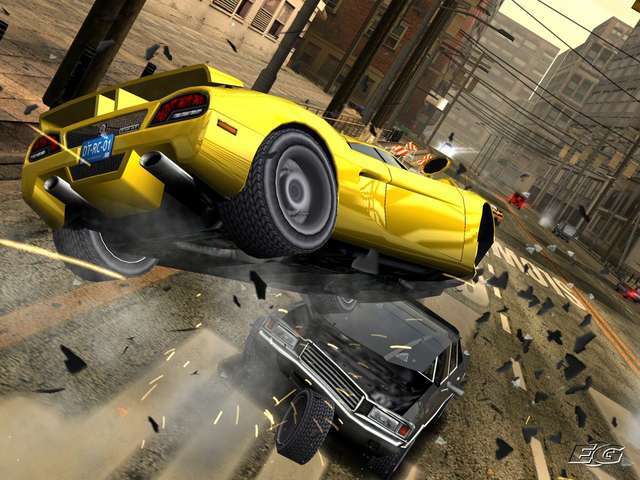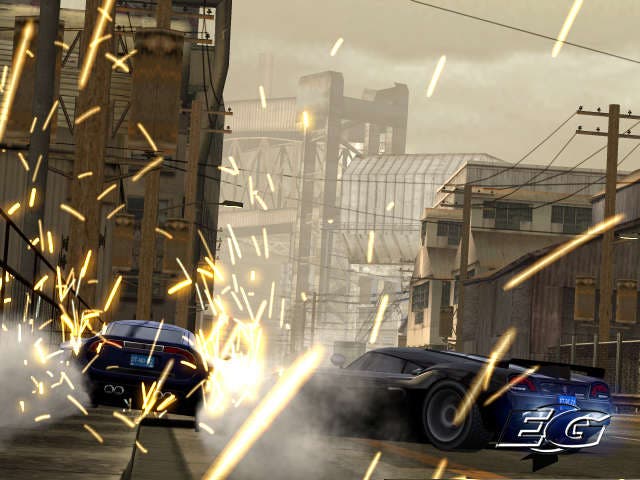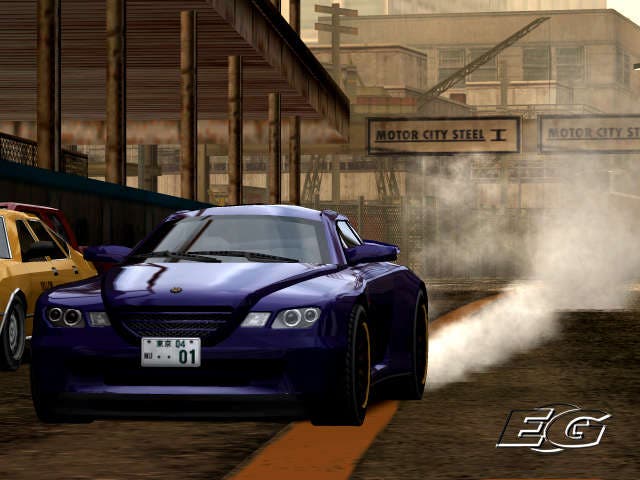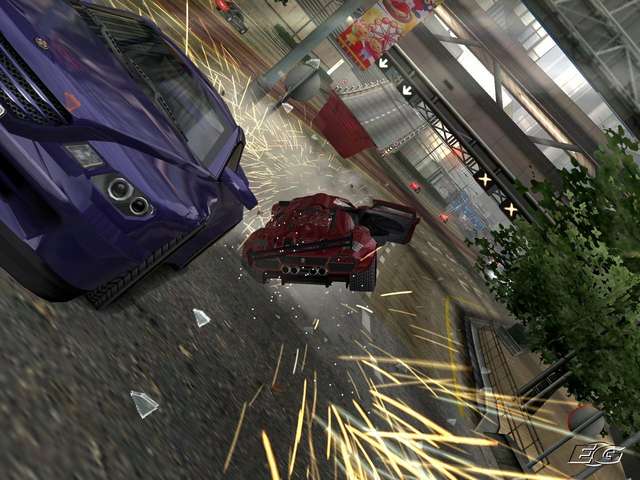Burnout Revenge
Is it as sweet as before?
Criterion's decision to literally sell out to Electronic Arts was a bit like seeing your favourite chart-flirting indie band shack up with a royalty-cheque-waving major label. You knew full well that stadium-filling super-stardom was just around the corner, and that the clever hooks and licks would be commodified into something more palatable and acceptable to the masses. You wearily accepted that your cool, best-kept secret was somehow never going to be the same again, although you knew deep down that they deserved the plaudits. And the cash.
And so it proved.
Last year's Burnout 3: Takedown was the pivotal release that went 'mainstream'. To see the brand finally getting the recognition it deserved was a great feeling. But at the same time, a chunk of the game's soul was sacrificed at the altar of cash. With an excitable DJ spinning a selection of ill-fitting US-centric 'punk' tunes, and a selection of made up buzzwords to describe the action, Burnout was rapidly becoming SSX on wheels. Sadly, that was the point. On top of that, a slightly rushed, bodged online implementation left many of us wondering what might have been.
Were it not for the fact that the core face-wobbling gameplay was still utterly majestic (for many, the best arcade racing game ever), we'd have probably vented our anguish a little more. As it was, most of what we were complaining about was the marketing direction, and acknowledging that it all felt a bit 'young' for us now.
Spot the difference
And now - uh oh - we're now deep into familiar EA annual update territory; usually the rocky road to creative doom, where genre-busting franchises are churned out into oblivion and we play a thousand-word game of spot the difference. You think we're joking.
But this is still Criterion we're dealing with, as opposed to Amorphous EA Games Studio Chertsey, and as such our expectations remain ridiculously high. Maybe too high. So, yes: version 4, otherwise known as 'Revenge'. Whether this is Criterion's revenge on us, EA, or multiple targets, it's not clear, but it has definitely taken notice of some of the core criticisms leveled at Takedown. They took the advice of Mr Morrissey and hanged the DJ, for a start. All is forgiven. Well, almost.
Even so, we had (and have) lingering concerns about whether the world actually needed another Burnout so soon. Like many people, the very concept of the annual update makes our flesh crawl. It's the smell of a money-making machine. What else was there to do, apart from continue to offering more tracks, cars and make it a better online game? It was already one of the best-looking games ever made, and playability wise was more or less spot on (albeit, arguably too easy) so adding technical bells and whistles wasn't necessary. Making it more challenging might have pleased the likes of us, but we all know the masses aren't terrifically keen on actually having to work for their fun.
Out of focus

So what did Criterion do? Quite simply, it has shifted the focus even further away from the traditions of racing games by now allowing (and in part tasking) the player to smash into the very same traffic you've spent the last three versions studiously avoiding. However ridiculous a concept that sounds (or looks when you see it running), there's no denying that Burnout Revenge is a very different game because of this new play mechanic - and one that has already stirred up a fair bit of controversy among the fan base. Some love the new mechanic, some despise it. It really is as simple as that.
To introduce players to this radical shake-up of the gameplay, Burnout Revenge's very first event chucks you right in the deep-end with the brand new Traffic Attack mode. Throwing you into a busy environment, this chaotic introduction passes by in a blur of twisted metal and glass shard as you slam into one vehicle after another in the name of 'Traffic Checking'. Like a steel-toe-capped boot applied to a child's toy car collection, you sweep all before you in a blizzard of metallic destructive insanity. It's utterly ridiculous, but in a sense entirely in-keeping with the progression of the series so far. Burnout has, after all, succeeded because of its utter rampaging ridiculousness. We love it because of it.
To lend this mayhem some sense of structure and purpose, you have to work against the clock in order to rack up a certain amount of 'checks' in order to win a medal. But continuing to smash up cars also gains you a small chunk of time to enable you to carry on to earn the ultimate prize of a Gold Medal and an Awesome rating. In a new and vastly superior progression system, the combination of medals and ratings allows you to earn up to five stars per event, with each star earned going towards improving your rank.
Holy progression system

In a nod to Gotham's progression system, you have eleven ranks to unlock, Revenge now has a far better way of measuring your progress, and lends a much greater incentive to go back and replay events to gain the remaining stars in order to unlock the harder ranks.
Within each rank reside an even greater assortment of Burnout events than ever, with the old school Race and Crash events now getting equal billing alongside the new Traffic Attack mode as well as the likes of Road Rage (take down as many designated opponents within a time limit, by whatever means necessary), Burning Lap (complete the circuit within a given time limit), Eliminator (the last-placed racer is eliminated every 30 seconds), Grand Prix (win a three race championship), and the Preview event (a chance to test drive some of the faster vehicles in the game in a one-off race).
The first thing to note is that our beloved Crash mode is as utterly, insanely brilliant as ever. There are only 40 Crash events in total (substantially down on last year's total of around 100), but the principle of Less is More definitely applies here. Not only that, there are some incredible, crazy, infuriating, addictive and downright demented junctions this time which really had us replaying them over and over. And - joy - Criterion has evidently admitted that Crash Multipliers are definitely a Bad Thing, having stripped them out this time around. Instead, you're now tasked with the simple premise of wiping as many vehicles as you can (with a specified limit this time, too), trying to mash up the moving takedown target as well as explode as many vehicles as you can. Part of this relies on building up your crashbreaker bar, and once it hits the magic 100 per cent mark, you must hammer the B button furiously within five seconds to launch your vehicle on an explosive journey to hit anyone who has been left out of your festival of carnage. It's still close to being the best fun ever, and, again, we'd buy the game simply to play this mode.
But, but, but.

Here comes the But. Outside of Crash mode, the racing-based gameplay has changed quite significantly. While events remain superficially unchanged from last year's Takedown, the ability to batter traffic out of the way radically changes the way you approach tracks and play events, making it in some senses less skilful, and in others more so. For much of the game, all you have to worry about is oncoming traffic, HGVs and immovable obstacles, making much of the game much easier than it used to be. In fact, despite the presence of around 169 events, you'll clear a hefty chunk of them with a Perfect rating on your first go. It's only in the latter stages, or when you're going for Gold that old campaigners will really have to work up a sweat, forcing you to play the game like a demented form of racing snooker - strategically smashing cars into opponents ahead or behind.
As great as it is to see new ideas in action (rather than just churning out more of the same), Revenge doesn't inspire the same palpitating sense of all-or-nothing immersion it once did. As much as we love winning, and clocking up those gold medals, some of our victories simply felt hollow, having been virtually handed to us on a plate. Unless you're one of those people that routinely likes to cheat your way through a game, the sense of achievement has been diminished thanks to traffic-checking. Much like Gotham 2, single-player progress can feel like a procession. Even Bronze medals are deemed good enough to allow you to fly through the ranks alarmingly quickly.
The main problem with racing in Revenge is that boosting is now virtually a given. It's almost permanent. The central racing mechanic of the first two Burnouts was to build up the boost bar through skilful driving and let rip at an appropriate moment, but in Revenge, you barely have to lift a finger to boost your way through entire events - again, diminishing the reward structure that was so perfectly balanced in version 2. To reflect that you've spent literally your entire time with your right index finger on the throttle and right thumb on boost illustrates what kind of game this is. Boosting should be a treat, a reward, but in Revenge you're spoiled rotten. Criterion needed to keep the balance poised, but it wants to pander to the less skillful gamer to sell more. We can understand wanting to make it more accessible, but there really should have been a way to ramp up the difficulty level for us old hands.
Check yourself

The chief component that tipped the balance too far is traffic checking. Being able to gain boost for smashing, as well as drifting, grabbing air, near misses, driving into oncoming traffic, rubbin', trading paint, takedowns and lord knows what else weighs the reward system way too generously toward the player. There's literally no more than few seconds in an entire race when you're not boosting, changing the finely tuned gameplay into something else; something that hardcore Burnout fans might not be entirely satisfied with. It's true that some of the latter events demand a more skillful approach, but that's assuming you even persist that far.
The question for Criterion is whether the 'hardcore' Burnout player is really a priority anymore, whether this vocal aficionado is the person it is pitching the game at these days, or whether Revenge is an exercise in changing the dynamics so that they become more accessible to the type of casual gamer that wants to feel like a gaming god without having to really try too hard. Was the Revenge project about making the best, most refined and entertaining Burnout game it could possibly be, or essentially delivering a safe, easy version of the experience that the masses can scream at like a trainload of riders on the Oblivion? And sell as many copies as Need For Speed Underground II?
It's a shame that Burnout has become less challenging and therefore less immersive as a racing game, because in all sorts of other respects it's an incredible achievement. Take the visuals, for a start. Praising Burnout for its looks is as useful as observing that an alcoholic likes a drink, but even so, the fact that Criterion is still managing to squeeze a little bit more out of the current generation technology is worthy of generous applause. And not only is it the best-looking of all driving games, it's the slickest, smoothest and fastest. Crank it up on a big, high definition screen and you'd swear you were looking at an early next-gen game (and having just seen what the 360 has to offer today, that's no exaggeration). We would like to register a small complaint, though, and that's the current trend (shortly to become an obsession) with 'blooming', the pseudo-High Dynamic Range effect which is supposed to simulate the effect of bright light bleeding into a darkened environment. Like FIFA 06, Burnout Revenge is often awash with the stuff, and it gives the effect of your TV's brightness being turned up too much. Frankly, we prefer the crisper way it used to look, though the game still looks fantastic, and is fearsomely fast, so it's more of a niggle than a serious complaint.
Hear my roar

Even in audio terms, the game excels whether it's delivering a roaring engine, a bone-crunching smash or the haunting slow-motion sounds when you've crashed. Top marks.
On the other hand, we're still not overly sold on the 41-strong US-centric soundtrack (though a handful of tracks are in our record collections, so it can't all be bad), but at least there's no DJ to spoil the party. Also, it's worth pointing out that if any track is particularly getting on your nerves you can either tell EA Trax to turn it off, or customise it entirely (on the Xbox only, obviously).
One area of the game that has definitely been much improved is the multiplayer portion. Takedown drew extensive criticism thanks to a horrendous front-end that dismissed the intuitive Xbox Live standard in favour of a bizarre use of regional lobbies, while assorted technical issues resulted in players being kicked off unreliable servers. On top of that, none of your hard-won single-player career achievements, times or scores were comparable with your online friends, which flew in the face of games like Project Gotham Racing 2, which succeeded by making every part of the game - both offline and online an integral part of the experience.
As far as the latter issue goes, Criterion has continued to ignore pleas to integrate the single-player with the online experience, but has at least ditched regional lobbies and made the online experience comparable with most standard Xbox Live games. Sadly, you still have to tediously agree to comply with EA's Ts&Cs before you can start, but after that you can get going with some six-player action just as you'd expect.
Play it again

Online play works on the basis of rank, starting every player off on level 50 for both Racing and Crashing. Within a few hours you'll have upped your rank considerably, which then basically rewards you with the ability to play with the cars you've already unlocked in single-player. Though this does feel slightly unnecessary if you've ploughed ten hours into the single-player game, it does mean you can't just go for the most powerful cars right away. In fact, until you've actually achieved the rank, you can't host matches of that given level, giving you a decent incentive to graft your way up.
Disappointingly, EA's servers have a bizarre tendency to kick out the sixth racer for no reason at all; an awful bug that we're amazed slipped through. You may imagine that it's just a vindictive host, but it is, we're informed, nothing to do with that. A patch will be forthcoming, no doubt, but for now you're going to have to make do with the issue. D'oh. Despite this massive oversight, the various online modes (of which there aren't many, with just a few variations on Crash and Race modes included) are enormous fun - though the interminable wait for others to finish their turn in Crash Party mode can get a touch tedious.
Whenever a game moves away from its original vision, there's always a backlash, and it's already apparent that Burnout Revenge is right in the midst of one right now. As far as we're concerned, we can fully appreciate the reasons why Criterion has chosen to go down this more commercial road, even if we don't particularly agree with it. Making the game easier, making it more accessible and delivering instant fun will probably result in better sales, so on that basis the game succeeds.
Rated completely on its own merits, Burnout Revenge is still an outstanding game, providing relentless entertainment. Crash mode is still as stupendously compelling as it ever was (righting the wrongs of Takedown) and is not only a massively addictive single-player game, but insanely good fun in six-player online mode. The real let down is the racing, in that it's simply not as much fun as it used to be, and as such Revenge can no longer be considered the best Burnout game. That's not to say it's "not fun", because we had a blast, but tasked with weighing it up against its predecessors, it's a slight backward step. Revenge may be a dish best served cold, but in this case, taking the heat out of the game wasn't what we were hoping for.


